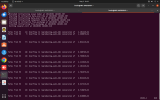Hi there all,
Can any one of you help me to fix the following error attached in the file? I want to use daily snapshot file to restart the model for my work. My daily snapshot file contains following variables as listed in the diag table form.
#"ocean_static", -1, "days", 1, "hours", "time" # ocean_static is a protected name. Do not change this line.
"ocean_daily_snapshot", 1, "days", 1, "hours", "time",
#"ocean_daily_mean", 1, "days", 1, "hours", "time",
# To generate daily_snapshot file
"ocean_model", "ssh", "sfc", "ocean_daily_snapshot", "all", "none", "none",2
"ocean_model_z", "thetao", "Temp", "ocean_daily_snapshot", "all", "none", "none",2
"ocean_model_z", "so", "Salt", "ocean_daily_snapshot", "all", "none", "none",2
"ocean_model_z", "uo", "u", "ocean_daily_snapshot", "all", "none", "none",2
"ocean_model_z", "vo", "v", "ocean_daily_snapshot", "all", "none", "none",2
"ocean_model_z", "rhopot0", "rhopot0", "ocean_daily_snapshot", "all", "none", "none",2
"ocean_model_z", "h", "h", "ocean_daily_snapshot", "all", "none", "none",2
Can any one of you help me to fix the following error attached in the file? I want to use daily snapshot file to restart the model for my work. My daily snapshot file contains following variables as listed in the diag table form.
#"ocean_static", -1, "days", 1, "hours", "time" # ocean_static is a protected name. Do not change this line.
"ocean_daily_snapshot", 1, "days", 1, "hours", "time",
#"ocean_daily_mean", 1, "days", 1, "hours", "time",
# To generate daily_snapshot file
"ocean_model", "ssh", "sfc", "ocean_daily_snapshot", "all", "none", "none",2
"ocean_model_z", "thetao", "Temp", "ocean_daily_snapshot", "all", "none", "none",2
"ocean_model_z", "so", "Salt", "ocean_daily_snapshot", "all", "none", "none",2
"ocean_model_z", "uo", "u", "ocean_daily_snapshot", "all", "none", "none",2
"ocean_model_z", "vo", "v", "ocean_daily_snapshot", "all", "none", "none",2
"ocean_model_z", "rhopot0", "rhopot0", "ocean_daily_snapshot", "all", "none", "none",2
"ocean_model_z", "h", "h", "ocean_daily_snapshot", "all", "none", "none",2

